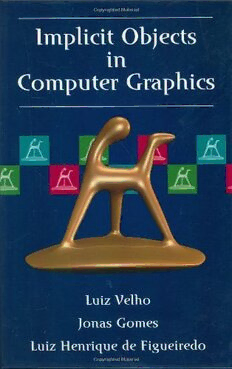
Implicit objects in computer graphics PDF
Preview Implicit objects in computer graphics
Implicit Objects in Computer Graphics Luiz Velho Jonas Gomes Luiz Henrique de Figueiredo Springer Implicit Objects in Computer Graphics Luiz Velho Jonas Gomes Luiz Henrique de Figueiredo Implicit Objects in Computer Graphics With 65 Figures LuizVelho JonasGomes LuizHenriquedeFigueiredo InstitutodeMatematicaPuraeAplicada RiodeJaneiro,RJ22460-320 Brazil LibraryofCongressCataloging-in-PublicationData Velho,Luiz. Implicitobjectsincomputergraphics/LuizVelho,JonasGomes,LuizHenriquede Figueiredo. p.cm. Includesbibliographicalreferencesandindex. ISBN0-387-98424-0(alk.paper) 1.Computergraphics. I.Gomes,Jonas. II.Figueiredo,LuizHenriquede. III.Title. TS385.V452002 006.6—dc21 2002016005 ISBN0-387-98424-0 Printedonacid-freepaper. 2002Springer-VerlagNewYork,Inc. Allrightsreserved.Thisworkmaynotbetranslatedorcopiedinwholeorinpartwithoutthe written permission of the publisher (Springer-Verlag New York, Inc., 175 Fifth Avenue, New York,NY10010,USA),exceptforbriefexcerptsinconnectionwithreviewsorscholarlyanalysis. Use in connection with any form of information storage and retrieval, electronic adaptation, computersoftware,orbysimilarordissimilarmethodologynowknownorhereafterdevelopedis forbidden. Theuseinthispublicationoftradenames,trademarks,servicemarks,andsimilarterms,evenif theyarenotidentifiedassuch,isnottobetakenasanexpressionofopinionastowhetheror nottheyaresubjecttoproprietaryrights. PrintedintheUnitedStatesofAmerica. 9 8 7 6 5 4 3 2 1 SPIN10658083 Typesetting:PagescreatedbytheauthorsusingaSpringerLaTeX2emacropackage. www.springer-ny.com Springer-Verlag NewYork Berlin Heidelberg AmemberofBertelsmannSpringerScience+BusinessMediaGmbH Preface Overview In this book we discuss the role of implicitly defined objects in com- puter graphics, within a coherent conceptual framework. We are con- cerned with the mathematical definition of shapes using an implicit form, as well as with its applications to geometric modeling, visualiza- tion and animation. Organization and Features The book is divided into five parts: mathematical foundations of ge- ometric models, implicit formulations for the specification of shapes, implicit primitives, techniques for constructing and manipulating im- plicit objects, modeling, rendering and animation implicit objects. Audience The book is useful to researchers and graduate students in computer graphicsandgeometricmodeling,andalsotoprofessionalsinthefields of CAD/CAM and special effects. Acknowledgments We wish to thank our colleagues of the VISGRAF Laboratory for providing a great research enviroment that stimulated our work in the area of computer graphics. We also thank our students from IMPA, PUC-Rio, and UFRJ, that participated in many activities related to the development of this book. iv Rio de Janeiro, November 2001 Luiz Velho Jonas Gomes Luiz Henrique Figureiredo Contents 1. Introduction ........................................ 1 1.1 Parametric versus Implicit.......................... 1 1.2 Motivation ....................................... 2 1.3 Scope and Overview ............................... 3 2. Manifolds ........................................... 5 2.1 Definition ........................................ 5 2.2 Local Charts ..................................... 6 2.3 Atlases and Structures ............................. 6 2.4 Calculus on Manifolds ............................. 8 2.5 Immersions and Embeddings........................ 9 2.6 Submanifolds ..................................... 9 2.7 Realizations of a Manifold.......................... 10 2.8 Manifolds with Boundary .......................... 11 2.9 Orientability...................................... 12 2.10 Classification of Manifolds.......................... 13 2.11 A Suitable Model ................................. 13 3. Parametric and Implicit Manifolds .................. 15 3.1 Parametrizations .................................. 15 3.2 Stratifications .................................... 16 3.3 Piecewise Descriptions ............................. 17 3.4 Implicit Description ............................... 19 3.5 Regularity and Transversality....................... 19 3.6 Implicit Manifolds................................. 20 3.7 Geometric Interpretation........................... 21 3.8 Algebraic Varieties ................................ 23 3.9 Algebraic Interpretation............................ 23 3.10 Parametric versus Implicit.......................... 24 vi Contents 4. Space Decompositions............................... 27 4.1 Types of Space Decompositions ..................... 27 4.1.1 Space Partitions ............................. 28 4.1.2 Cell Decompositions ......................... 28 4.1.3 Affine Cell Decompositions.................... 29 4.1.4 Simplicial Decompositions .................... 29 4.2 Properties of Space Decompositions ................. 32 4.2.1 Invariance .................................. 32 4.2.2 Uniqueness ................................. 33 4.2.3 Minimality.................................. 33 4.2.4 Finiteness and Local Finiteness................ 33 4.2.5 Regularity .................................. 33 4.2.6 Boundary Condition ......................... 33 4.2.7 Refinement ................................. 33 4.3 Algebraic Structure of Space Decompositions ......... 34 4.4 Spatial Data Structures ............................ 34 4.4.1 Topological Graphs .......................... 35 4.4.2 Trees....................................... 35 4.4.3 N-dimensional Arrays........................ 36 5. Shape and Space .................................... 39 5.1 Tubular Neighborhoods ............................ 39 5.1.1 Definitions.................................. 39 5.1.2 The Projection on the Surface................. 40 5.1.3 The Maximal Tubular Neighborhood ........... 41 5.2 Medial Axes ...................................... 41 5.2.1 Definitions.................................. 42 5.2.2 Intuition ................................... 42 5.2.3 Characteristics .............................. 43 5.3 Morse Theory .................................... 43 5.3.1 Critical Points and the Hessian ................ 44 5.3.2 Morse Function.............................. 44 5.3.3 The CW-Complex ........................... 45 5.3.4 Distance Fields as Morse Functions ............ 46 5.3.5 Topology of Implicit Shapes................... 47 5.4 Surfaces in Space.................................. 48 5.4.1 Surfaces Structuring Space.................... 48 5.4.2 What is a Good Implicit Model?............... 48 5.5 Universal Representation........................... 49 Contents vii 5.5.1 Medial Axis Models.......................... 49 5.5.2 Distance Function Models .................... 50 5.6 Summary ........................................ 50 6. Implicit Objects .................................... 51 6.1 Definition of an Implict Object ..................... 51 6.2 Mathematical Elements ............................ 53 6.2.1 The Function f ............................. 53 6.2.2 The Domain of f ............................ 54 6.2.3 The Characteristic Function .................. 54 6.2.4 The Gradient of f ........................... 54 6.2.5 The Hessian of f ............................ 55 6.3 Geometrical Characterization ....................... 55 6.3.1 Local Parametrization........................ 55 6.3.2 Orientation and Surface Normal ............... 56 6.4 Differentiable Attributes ........................... 56 6.4.1 Geodesics................................... 56 6.4.2 The Gauss Map ............................. 57 6.4.3 The Fundamental Forms...................... 58 6.4.4 Surface Curvature ........................... 59 6.5 Computational Attributes .......................... 60 6.5.1 Object Oriented Approach .................... 60 6.5.2 Basic Functions ............................. 61 7. Manipulating Implicit Objects ...................... 63 7.1 The Implicit Function as a Metric ................... 63 7.2 Properties of the Implicit Function .................. 65 7.3 Operations on the Range of F ...................... 66 7.3.1 Density Change ............................. 66 7.3.2 Mapping between Canonical Forms ............ 67 7.3.3 Complement ................................ 67 7.3.4 Dilations and Erosions ....................... 68 7.4 Mappings of the Embedding Space .................. 68 7.4.1 Affine Transformations ....................... 70 7.4.2 Deformations ............................... 70 7.5 Operations on the Domain of F ..................... 71 7.5.1 Analytical Transformation of F................ 71 7.5.2 Transformation of Points ..................... 71 7.5.3 Transformation of the Tangent Plane........... 72
